Source, by: Flags of the World





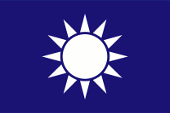
Naval jack,
ratio = 2:3,
Source, by: Wikipedia (EN)



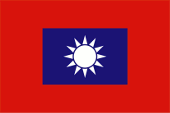
Flag of the Army,
ratio = 2:3 (3:4, 7:8),
Source, by: Flags of the World



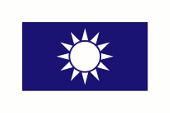
Flag for High Government Officials,
ratio = 2:3,
Source, by: Flags of the World



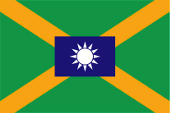
Flag of the Minister of Finance,
ratio = 2:3,
Source, by: Flags of the World




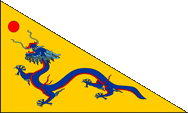
to 1895,
Taiwan Island belongs to China,
Source, by: Flags of the World,
!Original:清朝政府Vector: Sodacan,
Public domain, via Wikimedia Commons



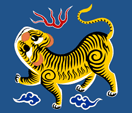
1895,
Flag of the "Republic of Taiwan",
ratio = 6:7,
Source, by: Flags of the World



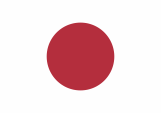
1895–1945,
Taiwan Island belongs to Japan,
ratio = 7:10,
Source, by: Wikipedia (EN)





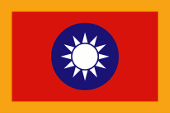
1929–1986,
Flag of the President,
ratio = 2:3,
Source, by: Flags of the World



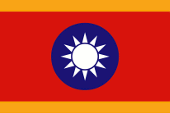
1947–1985,
Flag of the Vice President,
ratio = 2:3,
Source, by: Flags of the World



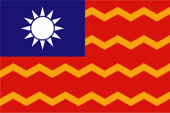
1929–1966,
Merchant flag,
ratio = 2:3,
Source, by: Flags of the World



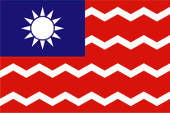
1929–1949,
Flag of the Water Police,
ratio = 2:3,
Source, by: Flags of the World



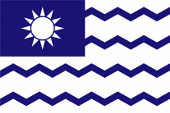
1929–1949,
Flag of the Salt Administration,
ratio = 2:3,
Source, by: Flags of the World



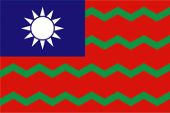
1931–1976,
Customs flag,
ratio = 2:3,
Source, by: Flags of the World




The flag of Taiwan is actually the flag of the Republic of China, which was introduced in 1912 as a naval flag. It was officially adopted as the Chinese national flag on 28th of October in 1928, with a red ground bunting and a white twelve-pointed sun (symbol of the Guomintang Party) in the blue upper corner. Red is the national colour of the Han Chinese, blue symbolises law, equality and justice, white stands for togetherness, brotherhood and openness. The sun symbolises the twelve double hours of the day and progress.
A reform movement, the Chinese Regeneration Society, had already been organised in 1895. The flag of this organisation was plain blue with a white twelve-pointed sun in the middle. In 1912, the National Republican Guomindang Party was founded. The Guomindang chose a single-coloured red flag with the blue flag of the Regeneration Society in the upper corner. The same flag was introduced as the Chinese naval flag in the same year. In a long civil war, the Guomindang finally prevailed in 1928. The Guomindang flag became the new national flag of China. The second Sino-Japanese War broke out in 1937 and lasted until 1945. In the following civil war, which lasted until 1949, the Communists prevailed against the Guomindang and founded the People's Republic of China. The Guomindang were able to escape to Taiwan, now the remaining territory of the Republic of China, so that its flags are still used on Taiwan.
The appearance and colours of the flag of the Republic of China (Taiwan) are laid down in Articles 3, 4 and 5 of Decree No. 47 of the National Government of 19 December 1928. It must be assumed that no specifications were made at that time regarding the colour tones. In this respect, they are probably not defined. However, as can be found on the website 'Flags of the World', Taiwan provided colour values for the 2012 Olympic Games in London in order to display the flags for the Olympics in the correct colours. The following colours were defined: Blue = Pantone 2748, light blue = Pantone 3005, red = Pantone 485, pink = Pantone 192, yellow = Pantone 137, green = Pantone 355.
Most of the special flags were abolished between 1949 and 1966. The last of these was the merchant flag with the yellow zigzag lines. The corresponding order stated that during the "period of mobilisation for the suppression of the communist rebellion", the merchant flag was to be replaced by the national flag. The merchant flag was thus abolished, although the "period of mobilisation" had been declared over in 1991.
Source:
Flags of the World,
Wikipedia (EN),
Die Welt der Flaggen,
Flaggen Wappen Hymnen,
National flagn der Welt,
Flaggen und Coat of arms of the Welt

The Republic of China (Taiwan) and the People's Republic of China are both still trying to portray themselves as the only "China", which has led to a situation where a state can only have relations with one China, either the People's Republic or the Republic. There are considerations and political forces on Taiwan calling for a departure from this one-China policy and for an independent Taiwan. The following flag was proposed for this state in 1996:
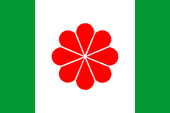
1996,
Flag of a from China independent Taiwan
ratio = 2:3,
Source, by: Wikipedia (DE)



The green color symbolizes the natural beauty of the island and the need to protect the environment, the white color represents the original purity of the people on the island, and the desire to preserve this natural beauty. The symbol in the middle depicts four hearts in harmony, representing the four population groups on the island: Aborigines, Hakka, Min-nan Taiwanese, and Mainlanders.
Source: taiwandc.org


Coat of arms of Taiwan (Republic of China),
Source, by: Wikipedia (DE)

The coat of arms of the state is the in 1895 introduced emblem of the Chinese Regeneration Society, the later Guomintang Party, a twelve-pointed white sun on blue ground. It symbolizes the twelve double-hours of the day and the progress.
Source: Flaggen Wappen Hymnen


since 1991,
Aircraft Roundel,
Source, by: Wikipedia (EN)
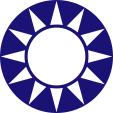
1928–1991,
Aircraft Roundel,
Source, by: Wikipedia (EN)

Location:
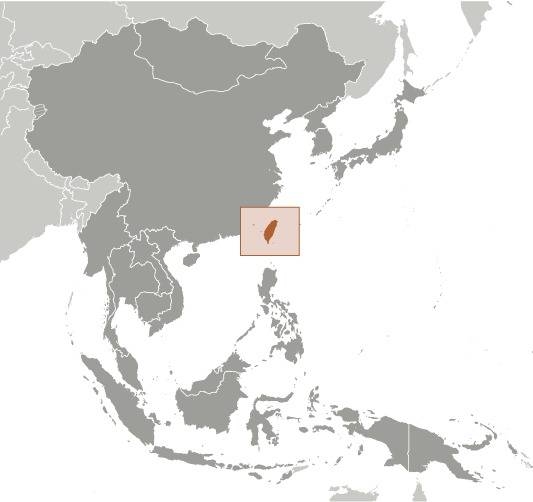
Source: CIA World Factbook
Map of the country:
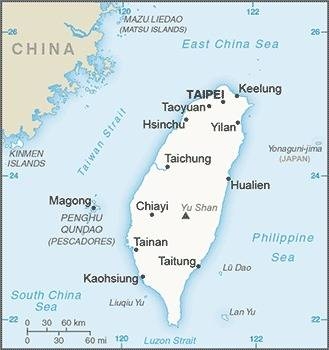
Source: CIA World Factbook

Area: 13.969 square miles (Taiwan Island, further the archipelagos of: Dongsha Qundao, Quemoy [Yinmen], Wu Chiu Yu, Matsu Dao, Penghu [Pescadores], Lan Yu, Peng Chia Yu)
Inhabitants: 23.580.712 (2022), thereof 98% Han Chinese (70 % Hokkien Min-nan, 14 % Hakka, 14 % Mainlanders), 2% Natives
Religions: 43,8 % Shen (Chinese folk religion), 21,2 % Buddhist, 15,5 % Taoist, 3,9 % Christian, 0,3 % Muslim
Density of Population: 1.688 inh./sq.mi.
Capital: Taipei (Japanese: Taihoku), 2.669.639 inh. (2018)
official Language: Madarin-Chinese
other Languages: Taiwan-Chinese, Hakka-Chinese, Hokkien-Chinese, English, Languages of the Natives
Currency: New Taiwan Dollar (TWD, NTD, NT$) = 10 Jiao = 100 Fen (Cents)
Time Zone: GMT + 8 h
Source:
Wikipedia (D)

early times · settlement of Taiwan coming from Southern Asia, from Taiwan colonization of Polynesia
12th century · first Chinese settlement
1517 · (by other sources in 1583 or even in 1590) discovery by Portugese seafarers, for some years operation of a Portugese trading base
17th century · massive Chinese settlement
1620 · establishment of the Dutch trading base Fort Zeelandia in the south of the island, colonization of the island
1626 · establishment of the Spanish trading base San Sebastian in the north of the island
1641 · expulsion of the Spaniard by the Dutchmen
1661 · conquest by Chinese troops of the Ming dynasty
1662 · expulsion of the Dutchmen by the Chinese
1683 · conquest by the Manchou (later Manchou dynasty in China), to the province of Fujian
1885 · Taiwan becomes a separate province of China
1894–1895 · Chinese-Japanese War
1895 · China cedes Taiwan to Japan, proclamation of the Democratic Nation of Taiwan (Republic of Taiwan), suppressed by Japan
1911 · revolution in China, fall of the Manchou dynasty
1916–1928 · civil war in China
10th of October 1928 · victory of the Guomindang Party, Proclamation of the Chinese National Government under Chiang Kai-Shek (Yiang Yieshi)
1937–1945 · Chinese-Japanese War, Japan occupies large parts of China until 1945
1945 · Japan has to cede Taiwan back to China
1945–1949 · war of the communists against the Guomindang
1947 · infliction of the state of emergency on the island
1949 · the Guomindang goes to Taiwan
1950 · Chiang Kai-Shek becomes president of Taiwan (Republic of China)
1975 · death of Chiang Kai-Shek
1987 · repeal of the state of emergency
1992 · change of constitution, end of the supremacy of the Guomindang Party
1996 · the People’s Republic of China rejects the independence of Taiwan
2001 · first dealings with the People’s Republic of China
2009 · further rapprochement with the People's Republic of China
2016 · sharp deterioration in relations with the People's Republic of China
Source:
Atlas zur Geschichte,
World Statesmen,
Wikipedia (DE)

"Taiwan" is Chinese and means "Big Bay", probably a hint to the many bays of the island. As the Portugese discovered the island they named it "Ilha Formosa", what means "Beautiful Island". The name Formosa is preserved until the today's times as name for the island, but the name "Taiwan" is now oftener in use.
Source:
Handbuch der geographischen Namen


![]()

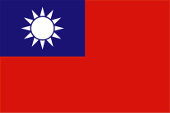






















![]()
